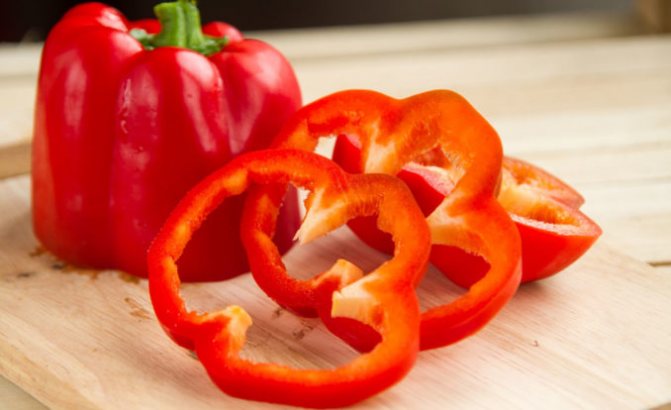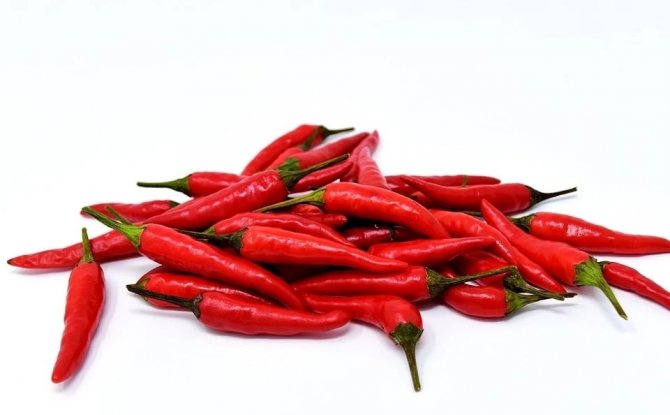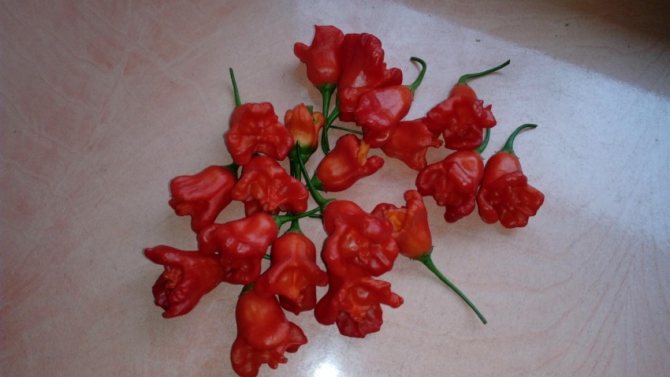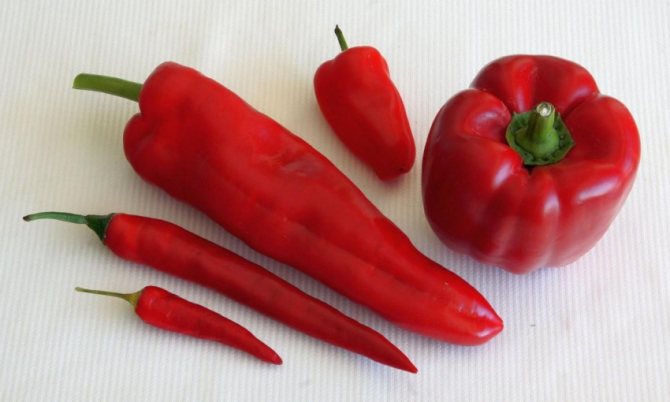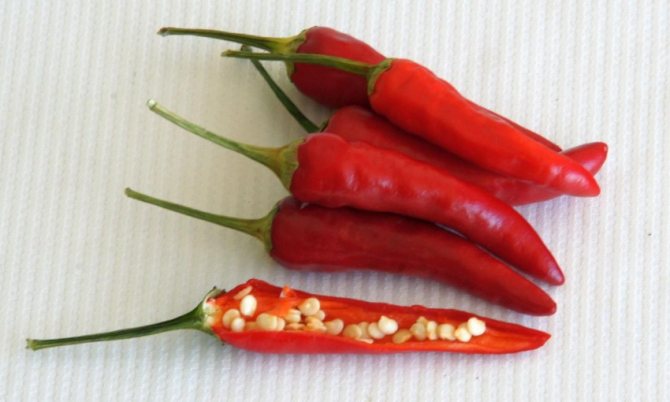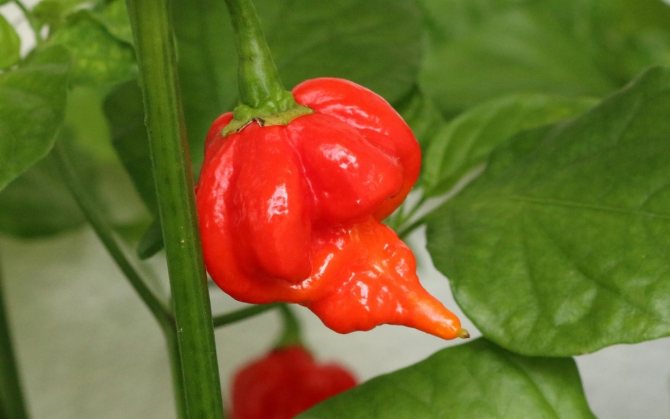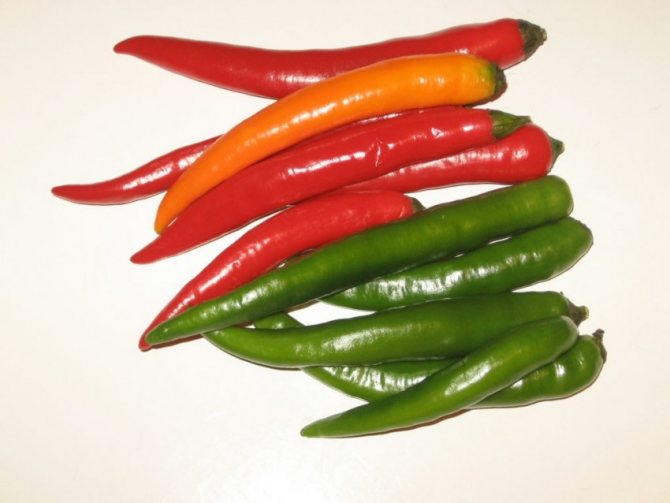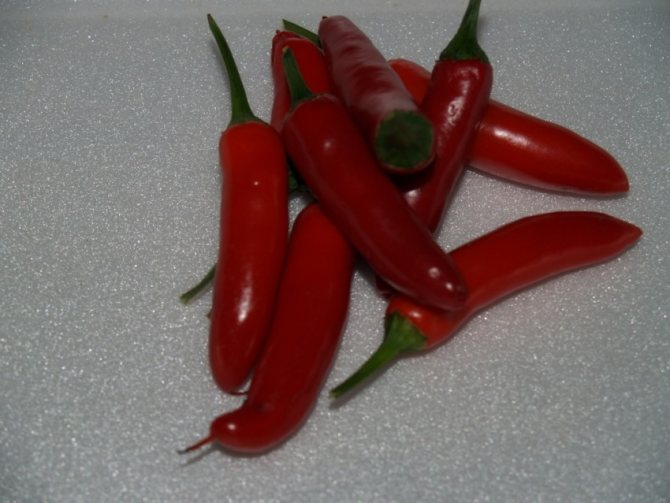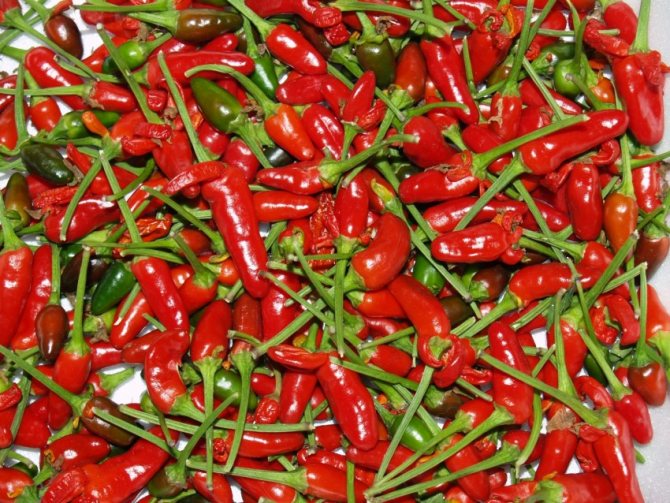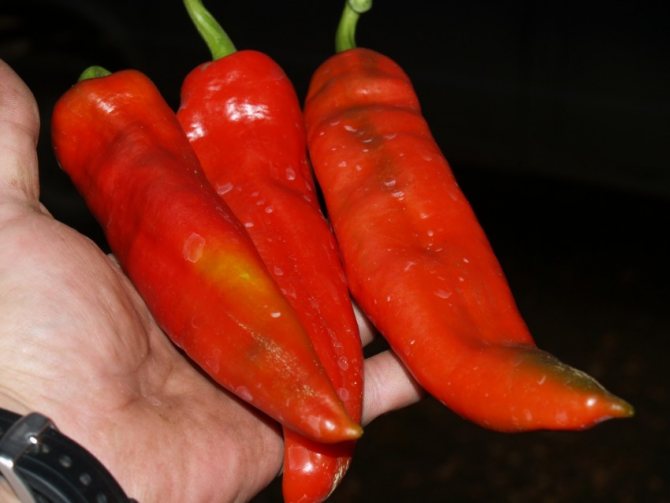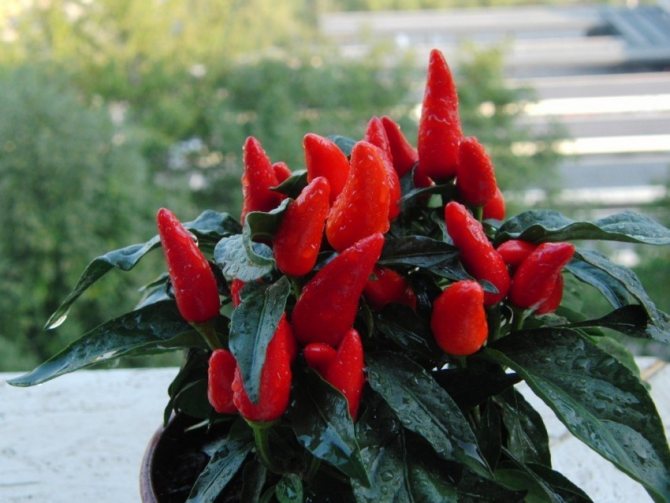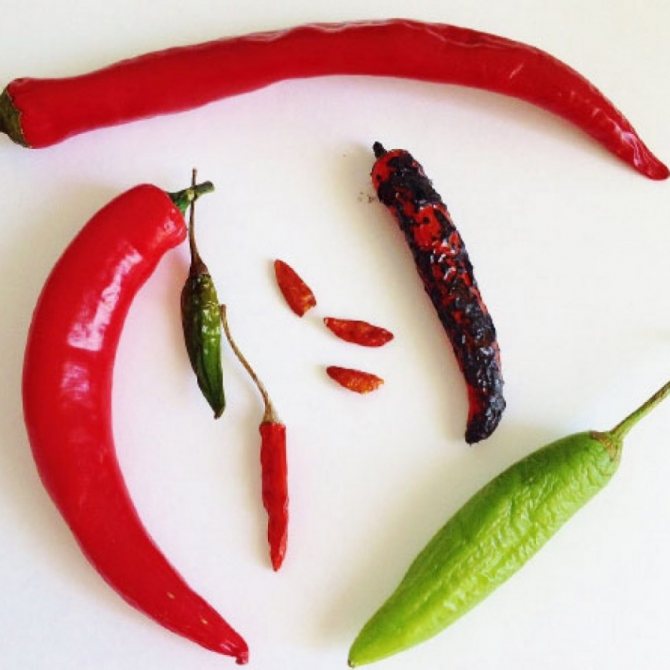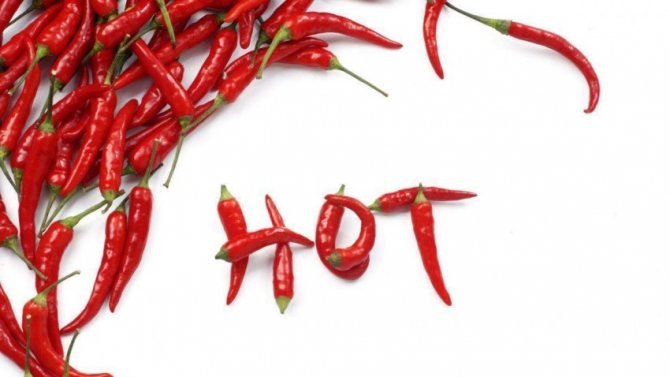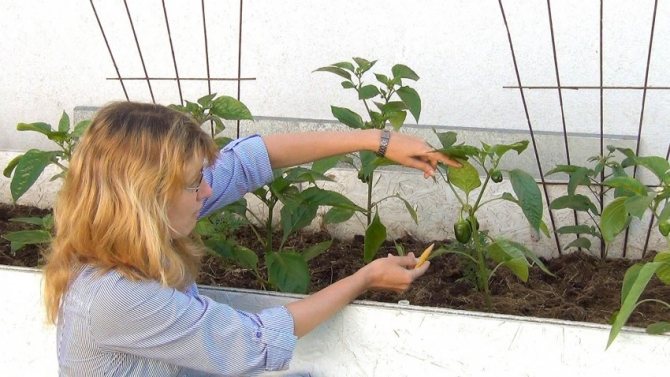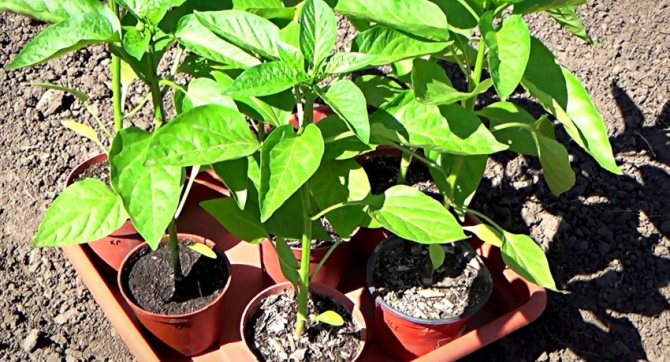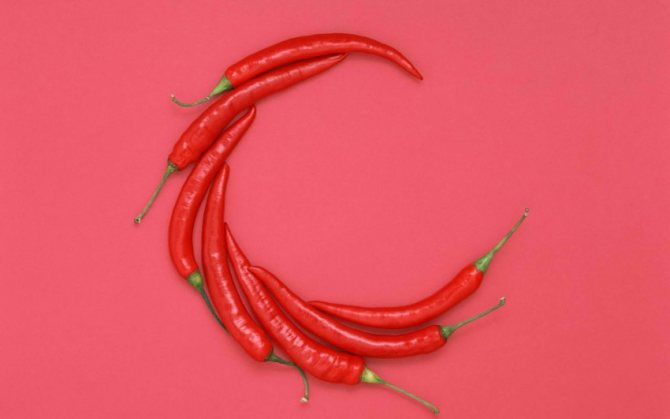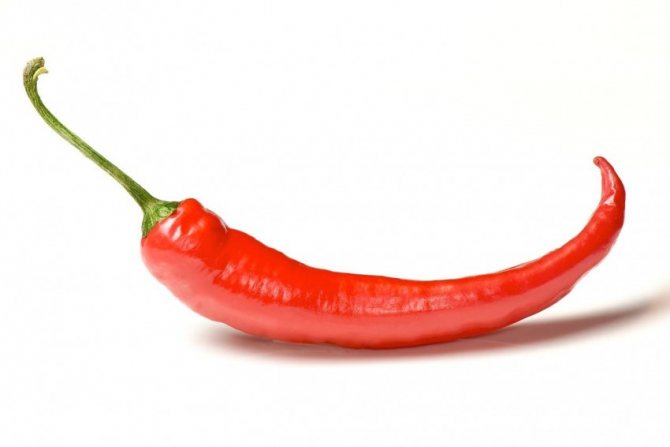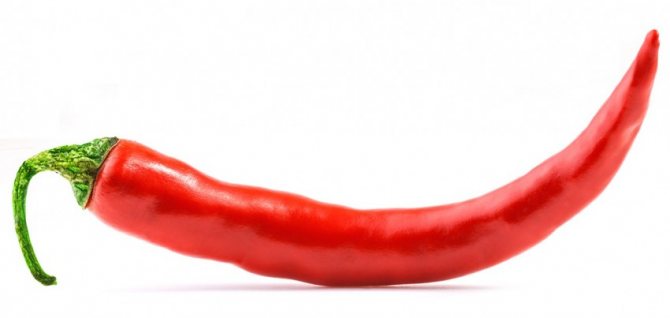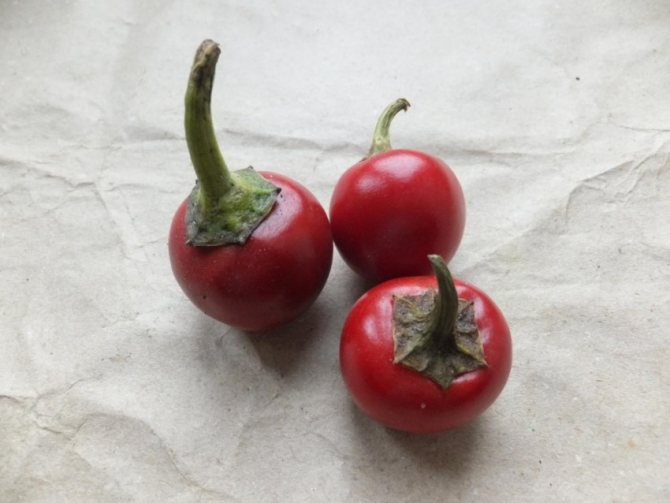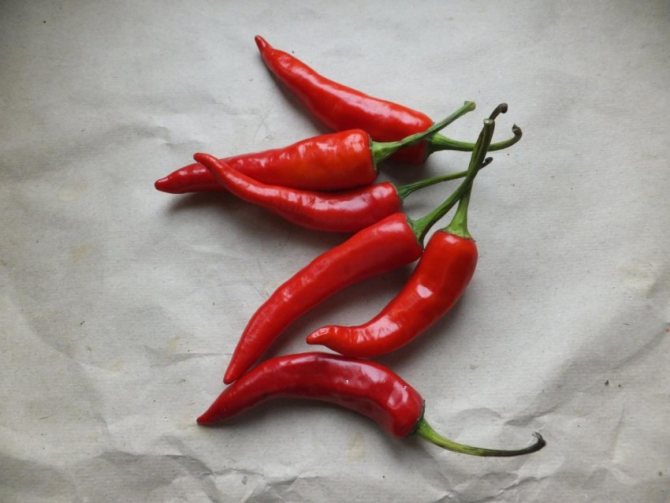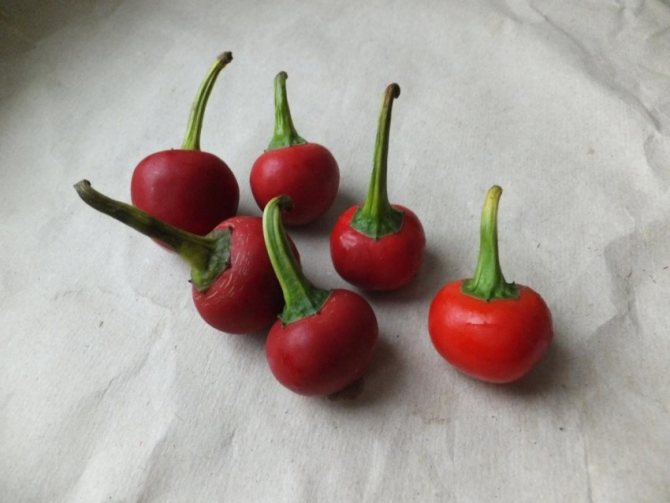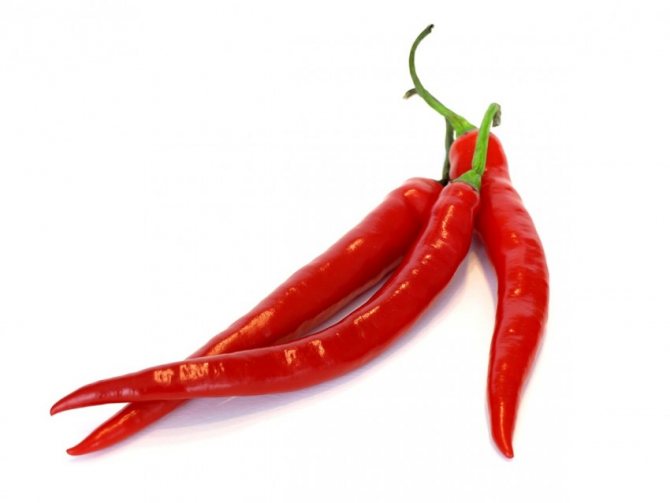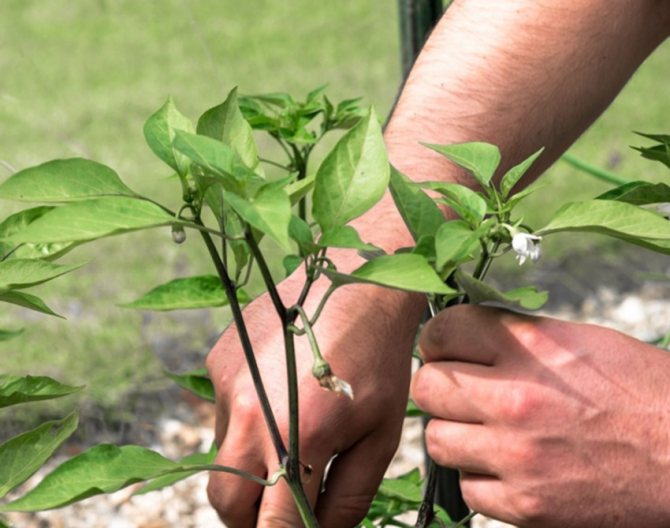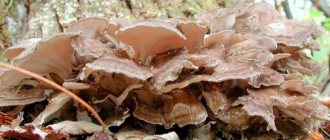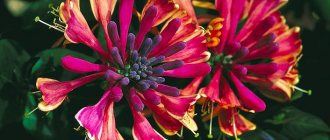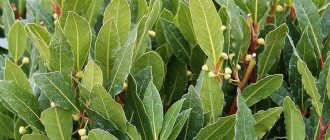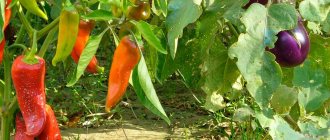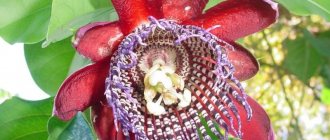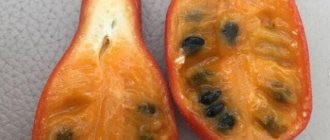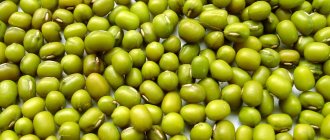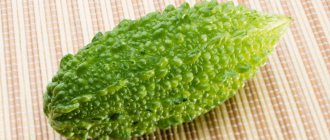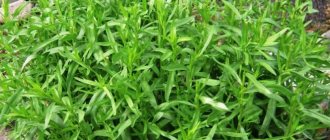Everyone knows about the dangers of an acute one for the liver and gastrointestinal tract, but have you tried to look at red pepper from the other side? Not as a spice, but primarily as a vegetable, because in addition to adding piquancy to dishes, it has a number of vitamins, both fresh and dry, ground.
Let's put aside prejudices and stereotypes about spicy foods and figure out the facts of how hot peppers are useful and what they are not.
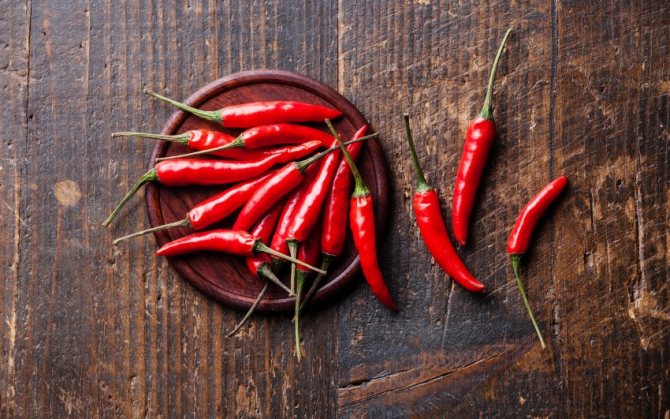
The red pepper known to us is obtained from the fruits of the shrub Capsicum frutescens or C. Annuum. A red pepper came to us from the tropical forests of North and South America.
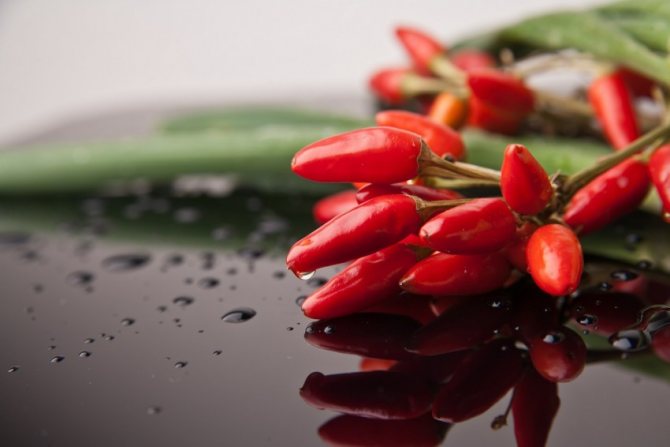

The fruits are known throughout the world as chili peppers. The fruits themselves can be not only red, but also orange, or even green. It is not the pulp of the pepper that is particularly acute, but the seeds and inner walls.


Calorie content and chemical composition of hot pepper
Red pepper is a real storehouse of valuable elements for humans.
Did you know? Hot peppers are included in the top 10 healthiest foods, compiled by experts from the World Health Organization.
100 g of the product contains a large amount of vitamins, including:
- A - 48 mcg (5.3% of the daily value for the human body);
- alpha carotene - 36 mcg;
- beta carotene - 0.534 mg (10.7%);
- beta cryptoxanthin - 40 mcg;
- lutein + zeaxanthin - 709 mcg;
- В1, В2 - 4.8% of the daily value;
- B4 - 2.2%;
- B5 - 4%;
- B6 - 25.3%;
- B9 - 5.8%;
- C - 159.7%;
- E - 4.6%;
- K - 11.7%;
- PP - 6.2%.
Capsicum is also rich in minerals: K, Ca, Mg, Ph, Fe, Se, Zn, Mn, Na, Cu.
The vegetable contains sugar, 10 essential, 8 nonessential amino acids, omega-3 and omega-6 fatty acids, 3 saturated, 1 monounsaturated, 2 polyunsaturated fatty acids. The energy value of 100 g of the product is 40 kcal. One pod contains about 18 kcal.
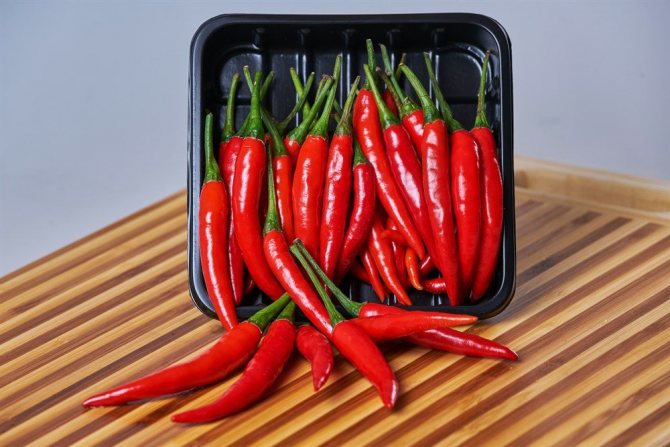

The nutritional value of 100 g of pepper is represented by the following components:
- proteins - 1.87 g;
- fats - 0.44 g;
- carbohydrates - 7.31 g;
- dietary fiber - 1.5 g;
- water - 88.02 g;
- ash - 0.87 g.
What is the difference between black peppercorns and red capsicum
Peppers used by mankind as a seasoning, from the point of view of biological science, are very heterogeneous. They can be divided into three large groups, each of which should be considered separately:
- Actually pepper (Piper) are plants of the Pepper family, genus Pepper. Everyone calls him "black pepper", photo:
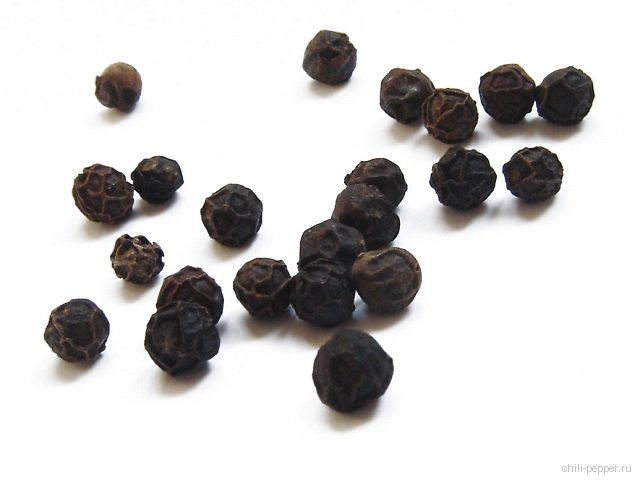

- Fruits of nightshade crops (relatives of tomatoes and potatoes) of the genus Capsicum. Usually referred to as "red pepper", photo:
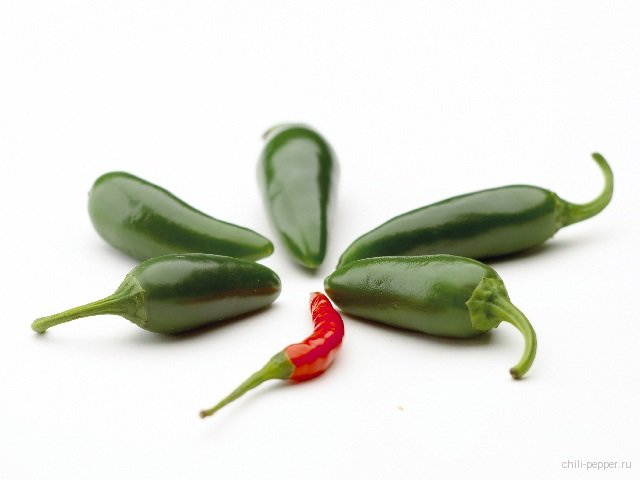

- Various allspice and other "not quite" peppers. We used to call it allspice.
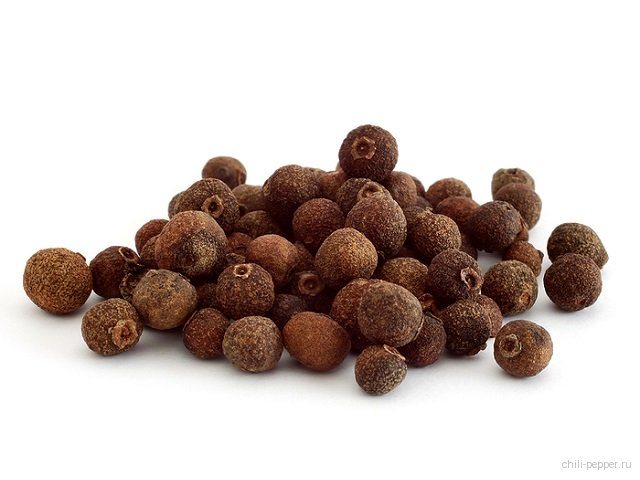

Plants of the Pepper family, genus Piper, real black peppercorns cultivated in many countries with tropical climates. These are small creepers that have clusters of fruits, when ripe, covered with a red shell. When fully ripe, black peppercorns without a shell are white (called "white pepper"). Ground black peas and ground white peas have different smells. Unripe peppers are called green peas.
Real black peppercorns cannot be confused with anything. His homeland is South India, Thailand, Indonesia. Long ago this spice was tasted by Europeans. He got to Europe along the Great Silk Road or from Arab suppliers. The price of these grains was more expensive than gold.Europe was constantly looking for its own way to access them and other spices.
From 5 ships of Magellan, after circumnavigation, a small sailing ship "Victoria" returned home to Spain, having on board a small amount of peppers and spices, which many times recouped all the costs of the trip. Now black pepper has become commonplace in any kitchen, it still smells of the tropics and is in demand by people.
Close relatives of the classic black pepper, Kubeba and long pepper are almost never found in modern Russian cooking. This is how they look:
Cubeba
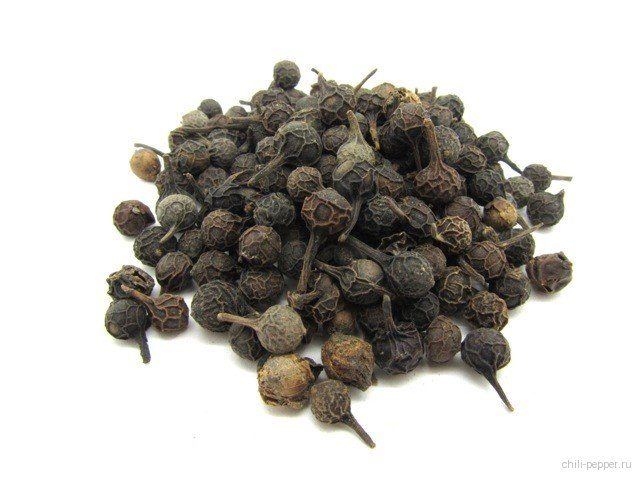

Long pepper
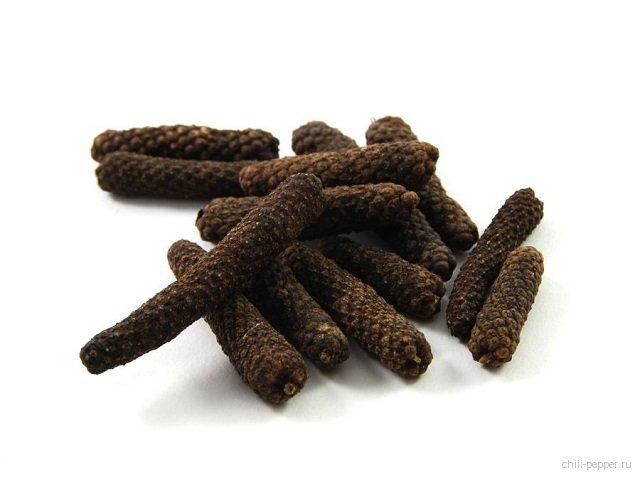

The plants listed above are a classic spice that has always been valued for aroma, not pungency.
Capsicum nightshade (Capsicum annuum L., Capsicum longum L.) "paprika" or "hot pepper" (group number 2) are distributed throughout the Earth. Even in Siberian gardens, Bulgarian sweet varieties and hot peppers from the Caucasus grow. As soon as they are not called: chili, paprika, Turkish, red, hot, hot, Mexican and 49 more names ... These fruits are especially good in warm regions - Ukraine, the Volga region, Uzbekistan and so on. Here in this article you can read about sweet varieties of yellow and green peppers.
The second hotter brother of the capsicum is cayenne (Capsicum fastigiatum Bl. And Capsicum frutescens). It has miniature bright red pods. One fruit can turn a 5 liter pot of borscht into volcanic lava. It is to this family of nightshades that the famous Jalapeno and Habanera varieties belong.
Briefly about group # 3. This is primarily allspice, also called "allspice", which is famous for its aroma, as well as plants of the Xylopia genus, such as the African pepper variety (Kumba). Javanese and Japanese peppers are also popular in local cuisine.
The benefits and harms of hot peppers for the health of men and women
Hot peppers are used in their national cuisines by many nations of the world. He also found application in official and traditional medicine, the field of beauty. After analyzing the composition of a vegetable, you can see how it can be useful for humans.
- Among the beneficial properties of red pepper for men and women should be mentioned:
- restorative effect;
- resistance to bacteria;
- preventing the formation of tumors;
- elimination of pain;
- preventing the development of diabetes;
- diaphoretic;
- antipyretic;
- anti-infarction and anti-stroke;
- lowering blood cholesterol levels;
- prevention of thrombosis;
- promoting weight loss;
- improved metabolism;
- positive effect on potency in men;
- improved testosterone production;
- normalization of the menstrual cycle in women;
- normalizing hormonal levels;
- acceleration of hair growth;
- beneficial effect on blood circulation;
- calming the nervous system;
- increased production of endorphins;
- improved appetite.
Red peppers are known to cause severe allergies and skin burns. Allergy is manifested by skin rashes, burning, itching. In severe cases, drowsiness, indigestion, fever, and chills may occur. Whether this product is harmful (if so, to what extent), scientists are still investigating.
Important! When working with hot peppers, you must protect your hands with gloves and make sure that your hands do not touch your face (especially your eyes). If pepper juice gets on the skin or mucous membranes, wash the affected areas with plenty of water.
Fruit composition properties
Fruit composition. They contain about 0.7% capsaicin amide, steroid saponins, wax, essential, fatty oils, coloring agents, vitamin C, carotene, vitamins B1, B2, B6, P, minerals - magnesium, potassium, iron and others.
Fruits of some varieties contain vitamin C more than other vegetable plants - 250 mg of ascorbic acid per 100 g of fruit.
Vitamin P - rutin in combination with vitamin C lowers, normalizes the permeability of the walls of blood vessels, improving their elasticity and strength.
Research by Chinese scientists has shown that regular consumption of red hot peppers helps prevent hypertension.
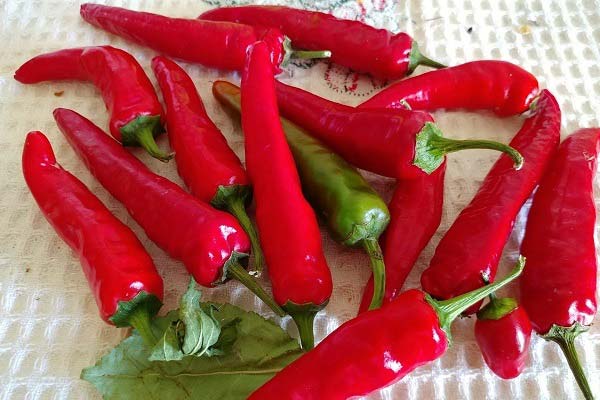

The pungent taste of the fruit is provided by the alkaloid capsaicin, it is most of all in the septa and seeds inside the pod, thanks to which the spice has a burning taste, irritating properties. Capsaicin is a strong natural antibiotic; the hotter the pepper, the more pronounced its medicinal properties. The essential oil gives the fruit a strong spicy aroma.
It can be so burning that it can cause severe irritation when it comes into contact with the skin, so when preparing it, you need to use rubber gloves and not touch your eyes and mucous membranes. After work, wash your hands well with soap and water.
From my own experience. The first time I cooked red hot pepper for the Fire - I washed it, cleaned it of seeds, after that I had to keep my hands in cold water to relieve this burning, my hands were so intolerably burning.
If it burns in your mouth from hot pepper, you can extinguish the fire by drinking milk, kefir or eating a tomato, a sour orange slice - to interrupt this pungency.
Contraindications to use
There are several categories of people who are contraindicated to eat hot peppers.
- These include:
- people with kidney and liver diseases;
- ulcers and suffering from gastrointestinal diseases;
- diagnosed with diabetes mellitus;
- with a history of hemorrhoids;
- with individual intolerance to the product;
- women during menstruation;
- breastfeeding.
[/ ul
With caution, the product should be used for hypotensive patients. Like all spicy foods, peppers should not be eaten by women who are carrying a child. The ban was introduced because of the side effects that this vegetable can cause - heartburn, increased thirst, stress on the liver.
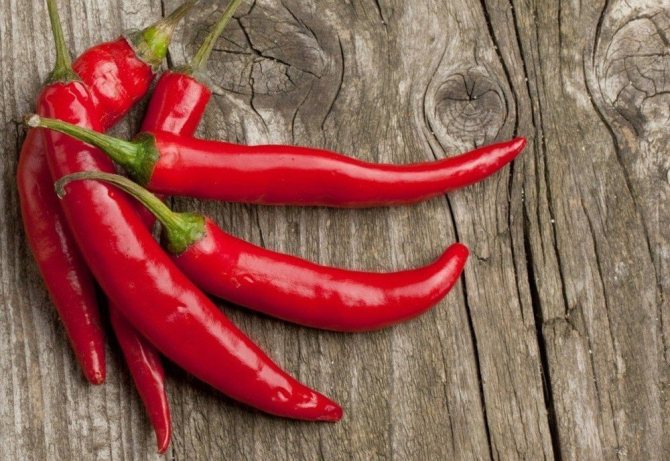

Many pregnant women already often experience problems with the digestive tract, so eating foods that can aggravate them are not worth it (along with those foods after which you want to drink a lot). This can lead to swelling, which threatens the onset of gestosis ("late toxicosis"). You can not eat spicy and children. The ban applies to the category up to 15-16 years old. Such food irritates the still delicate lining of the stomach and can lead to early gastritis or ulcers.
Consumption rates per day
Despite the many beneficial effects that a hot vegetable has on the functioning of the human body, it does not need to be consumed daily and in large quantities. To get only benefit from it, it is enough to enter it into the weekly menu only 1-2 times. You can eat no more than 15 g per day (approximately half of the pod).
Also read on how to grow chili peppers at home on a windowsill.
How to grow, care, pests and diseases
Considering how sweet peppers love heat and sun, growing this fruit crop will not be easy. To get a large harvest at home, you need to take into account the characteristics of this plant and its intolerance to cold.
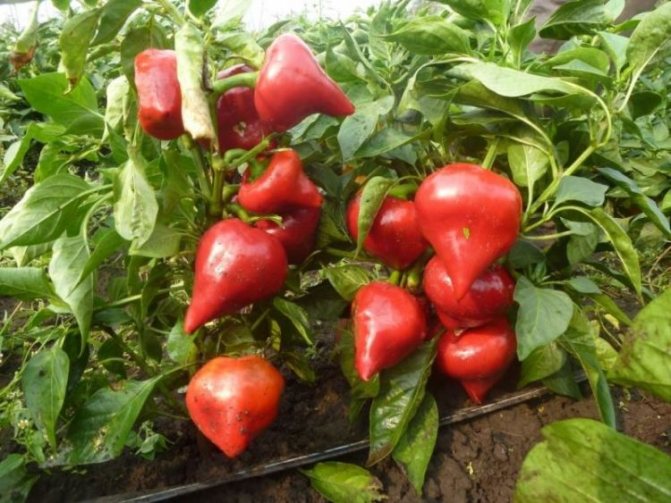

For the seedling method, prepare bags with a mixture of earth and humus - this will help not to damage the roots. Then they select good seeds or use purchased ones and place 3-4 pieces in a moistened bag, and then put them in a well-lit place. After emergence, the temperature must be lowered so that the sprouts get used to the coolness.
Seedlings need to be watered about 1 time in 2 days and at the same time make sure that the water does not stagnate. When 4-5 leaves appear on the stalk, watering is carried out daily. Planting is carried out at the end of April, sprouts are placed in the prepared holes along with an earthen clod and sprinkled with dry earth. You need to moisten the soil the next day and then you need to monitor so that the earth does not dry out. After 10-15 days, the first feeding is done, in this case, the seedlings will take root faster and give a rich harvest.
For soil planting, sweet pepper seeds, photos of which can be easily found, should be placed in prepared holes, 4-5 pieces in each and covered with earth. After the first shoots have appeared, leave 1-2 plants, water them, loosen the soil and feed them as in the case of the seedling method.
In most cases, such a plant suffers from cold weather and fungal diseases. All this can be avoided if the cultivation technology, watering is properly followed, when the plants are treated with special antifungal agents. In addition, the cultivation of this fruit crop is associated with such pests as aphids, spider mites, slugs and even the Colorado potato beetle. In this case, an individual approach is required depending on the type of pest.
Application features
The rich vitamin and mineral composition of the product contributes to the fact that it is used in various fields (most often in cooking).
In folk medicine
In official medicine, red hot pepper is included in the composition of a medicinal plaster, which is recommended to be used for pain in muscles and joints, arthritis, rheumatism. Pharmaceuticals produces pepper tincture used to normalize hunger and the functioning of the digestive system. There are pepper-based remedies for malaria and frostbite.
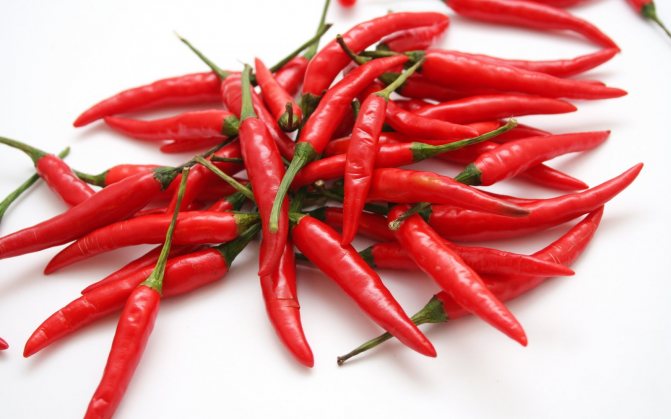

Pepper is one of the ingredients in Tonsipret, which is recommended for diseases of the upper respiratory tract. In homeopathy, hot vegetable extracts are prescribed for the treatment of cystitis, urethritis, colitis, pyelonephritis, urolithiasis, otitis media, acute respiratory viral infections, gastritis with high acidity. Traditional healers make tinctures, infusions and decoctions from a spicy product.
Infusions are used in the fight against:
- arthritis (10 pods, ground in a blender + 250 g of unrefined vegetable oil (from corn or sunflower) + 250 ml of refined kerosene; leave for 7 days);
- vitiligo.
The tincture is prepared by mixing 70% alcohol with finely chopped pods in a ratio of 1 to 3 or 1 to 5. Insist for 21 days.
Find out also
What is the difference between cayenne pepper and chili?
She is treated:
- genital herpes;
- enterocolitis;
- dysentery;
- gout;
- radiculitis.
Broths are used to treat colds (pour 200 ml of milk into the crushed pod; cook for 2 minutes). To get rid of cough, bronchitis, mix the crushed pod with 1 tbsp. l. honey.
The product is divided into 8 parts, eaten 1 part 2 times a day. Ointment with the addition of a vegetable relieves pain in osteochondrosis, injuries and bruises of the extremities, neuralgic problems, arthritis, gout, inflammation of muscles and joints. It is prepared by mixing 0.5 tsp. pepper, 1 tsp. 30% alcoholic propolis tincture, 1 tsp. propolis, 1 tsp. glycerin, 1 tsp. turpentine, 2-3 drops of essential oil. The mixture is heated in a water bath until a homogeneous mixture is formed.
In cosmetology
Red pepper is an effective remedy for baldness and for stimulating hair growth, strengthening the roots, and improving blood circulation. It is included as an ingredient in medicated shampoos and masks. Means based on hot vegetables strengthen the nail plate.
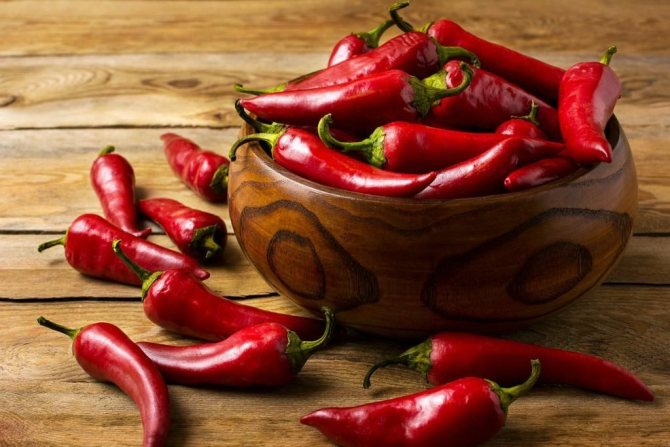

Another property of pepper, which has been actively adopted by cosmetologists, is anti-cellulite. It allows you to effectively break down fats. Pepper extracts are included in anti-cellulite creams.
Here are some popular beauty recipes:
- Against cellulite. The areas where the "orange peel" has formed are rubbed with pepper tincture. If the skin reacts too painfully to the tincture, then a few drops of it are added to the anti-cellulite cream.
- Against peeling nails. Mix 1 tsp. hand and nail cream, 0.5 tsp. ground pepper, 15 drops of water and citric acid on the tip of a knife. Place the mixture in a water bath for 15 minutes, stirring constantly. Lubricate nails with a cooled agent and wrap with foil. Leave for 20 minutes. To achieve the effect, the procedure must be repeated (2 times a month).
- Against hair loss. Mask from 1 tbsp. l. pepper tincture, 2 tbsp. l. castor oil, 2 tbsp. l. apply the shampoo to the scalp for 1–1.5 hours. Cover your head with plastic wrap and wrap with a towel.
- For active hair growth. Combine 100 ml of brandy and 10 g of ground pepper. Place in a dark place for 7 days. Then strain and dilute with boiled water (proportion: 1 to 10). Apply by rubbing into the scalp at night for 1-2 months at intervals of 7 days.
By
The best varieties and hybrids of peppers with red fruits
By the way! The most popular varieties of sweet red peppers are (in terms of popularity): California miracle, Bogatyr and Swallow - three major hits. Also very common are such varieties of bell peppers as the Star of the East, Kakadu, Belozerka, Atlant. In addition, Volovye's ear, Gift of Moldova, Winnie the Pooh, Claudio and others won the love of the people.
Agapovsky
- The variety is early maturing. The period from full germination to technical ripeness is 99-120 days.
- For open ground and film shelters.
- The plant is compact, of medium height, highly leafy.
- The fruit is drooping, prismatic, smooth, slightly ribbed, dark green in technical ripeness, red in biological ripeness. The number of nests is 3-4.
- Wall thickness - 5.0-8.0 mm.
- Weight - 114-120 g.
- Productivity - 9.5-10.3 kg per sq.m.
- The taste is good, the aroma is strong.
- Universal use: fresh, in home cooking, for canning.
- Slightly affected by apical fruit rot. Resistant to tobacco mosaic virus.
Atlant
- Mid-season variety. The period from germination to fruiting is 130 days.
- The plant is sprawling, tall, 70-75 cm high.
- For open ground and foil greenhouses.
- The fruit is drooping, conical, highly glossy, the color is green in technical ripeness, in biological ripeness - red. The number of nests is 3-4. Fruit length - 18-20 cm, diameter - 13-14 cm.
- Wall thickness - up to 8-10 mm.
- Weight - 180-190 g.
- Productivity - 3.1-3.3 kg per sq.m.
- Recommended for fresh use, home cooking and canning.
- It tolerates unfavorable weather conditions. Resistant to tobacco mosaic virus.
Belozerka
- Medium early grade. From germination to technical ripeness - on average 114 days (according to other sources, 115-120 days).
- For open ground and film shelters.
- The plant is standard (half-stem), compact, 40-70 cm high.
- Fruits are pendant, aligned, conical with a pointed tip, smooth, light cream in technical ripeness, red in biological ripeness, 2-3 chambered.
- Wall thickness - 5-6 mm.
- Weight - 70-100 g (maximum up to 140 grams).
- Productivity -6-8 kg per sq.m.
- The taste of fresh fruits is excellent, marketability and transportability are high.
- Recommended for fresh consumption, canning and culinary processing.
- Resistant to verticillium wilt, Alternaria, tolerant to the tobacco mosaic virus.
Bison red
By the way! There is also the variety "Yellow Bison".
- The variety is early ripe (95-105 days from germination to technical ripeness).
- Recommended for growing outdoors (southern regions) and greenhouses.
- The plant is semi-spreading, powerful, about 90 cm high.
- Fruits are elongated-conical, glossy, the length of some reaches 25 cm. The color is green in technical ripeness, in biological ripeness - red. Number of nests - 3-4
- Weight - 150-200 g.
- Wall thickness - 4-5 mm.
- Productivity - up to 10 kg per sq.m.
- The walls are juicy and sweet, remain unusually tender both in unripe green fruits and in ripe dark red ones.
- Suitable for preparing fresh salads, frying, stewing and stuffing.
- Long-term fruiting will ensure regular harvest of fruits until late autumn.
Bogatyr
- The variety is mid-season. Fruit ripening occurs in 115-131 days.
- The plant is tall, spreading, 55-70 cm high.
- Recommended for growing in personal plots and in film greenhouses.
- The fruit is pendant, conical, slightly ribbed. The top of the fruit is ribbed. Coloring in technical ripeness is light green, in biological ripeness - red.
- The thickness of the fruit wall is 4.9-5.8 mm.
- Fruit weight - 75-100 g (maximum - up to 160 grams).
- Productivity - 2.1-4.3 kg per sq.m.
- The fresh fruit tastes good and excellent.
- For fresh use and canning.
- Resistant to tobacco mosaic virus. It is slightly affected by verticillary wilting and apical rot of fruits.
Viking
- The variety is early maturing. From germination to fruiting 105-115 days.
- For growing in the open field and under film shelters.
- The plant is semi-spreading, of medium height.
- The fruit is drooping, cylindrical, smooth, glossy, green in technical ripeness, red in biological ripeness. The number of nests is 3-4.
- Fruit wall thickness - 4-5 mm
- Fruit weight - 90-110 g.
- The taste is excellent, sweet, juicy, aromatic.
- Universal use: recommended for fresh use, for home cooking and for canning.
Winnie the Pooh
- Early ripening variety (107-111 days from germination to fruiting).
- For open ground and film shelters. Suitable for growing on a window.
- The plant is undersized, compact, 25-30 cm high with a bouquet arrangement of fruits. To obtain the maximum yield, the plants are planted thickened.
- The fruit is cone-shaped with a pointed tip, weighing 48-60 g. The color in technical ripeness is salad, in biological ripeness it is red.
- Wall thickness - 5-6 mm.
- Weight - 48-60 g (maximum - up to 70 grams).
- Productivity - 1.6-1.8 kg per square meter (maximum - up to 5 kg).
- Good taste. Universal purpose.
- Resistant to verticillary wilting and aphid damage.
- Suitable for transportation and long-term storage.
Cow's ear
- The variety is mid-season. The period from germination to the beginning of fruiting is 120-130 days.
- For open ground and plastic greenhouses.
- The plant is spreading, of medium height, about 70 cm.
- The fruit is corrugated, elongated-conical in shape. Coloring in technical ripeness is dark green, in biological ripeness - deep red. Fruit length - 12-16 cm.
- Wall thickness - 6-8 mm.
- Weight - 120-140 g (up to 250 g).
- Productivity - 3.2 kg per sq.m.
- The taste is great.
- Universal use: for fresh use, home cooking and canning.
- It retains its attractive appearance and turgor for a long time. Transportability is excellent.
- Fusarium resistant.
Hercules
- The variety is late ripening. The period from planting seedlings to fruiting is 135-145 days.
- For open and protected ground.
- The plant is semi-spreading, of medium height.
- The fruit is drooping, cuboid, 11-12 cm long, 10-11 cm wide. The color is red in biological ripeness, and green in technical ripeness. The number of nests is 3-4.
- Wall thickness - 5-7 mm.
- Weight - 150-160 g
- Productivity - 2.6 kg per sq.m.
- Excellent taste.
- Universal use (fresh, home cooking and canning).
- Fusarium resistant.
Gypsy F1
- The hybrid is early maturing.
- The plant is semi-spreading, medium-sized.
- Fruits drooping, cylindrical, 3-4-nested, 10 cm long, 6 cm in diameter, weight, glossy. The color of unripe fruits is yellow, ripe fruits are red. The number of nests is 2-3.
- Wall thickness - 6-8 mm.
- Weight - 100-150 g.
- Productivity - 3.7-4.5 kg per sq.m.
- Great taste.
- Recommended for fresh use, home cooking and canning.
- Resistant to tobacco mosaic virus.
Star of the East F1
Note! The Star of the East hybrid is also presented in the following color shades: White, Yellow, Golden, Red, Tangerine, Orange, Purple, Chocolate.
- Early ripe hybrid (105-110 days).
- For open and protected ground.
- The plant is medium-sized, semi-spreading, up to 70-80 cm high.
- Fruits are drooping, cuboid, glossy, creamy white in technical ripeness, with a transition when ripe to creamy red, in biological ripeness - red.
- Wall thickness - 6-8 mm.
- Weight - 150-180 grams.
- Productivity - 7.0 -7.5 kg per sq.m.
- The fruits are juicy and have excellent taste.
- Resistant to tobacco mosaic virus and verticillium. Suitable for long-term transportation.
- The purpose of the fruits is universal: for fresh use, home cooking and for canning.
The original transition of color and taste allows harvesting fruits at different stages of ripening.
Player
- The variety is early maturing (100-105 days).
- For greenhouses, tunnels, open ground.
- The plant is semi-spreading, medium-sized, 45-50 cm high.
- The fruits are drooping, large, cuboid, medium-silvery, glossy, light green in technical ripeness, deep red in biological ripeness. The number of nests is 3-4.
- Wall thickness - 9-12 mm.
- Weight - 130-150 grams.
- Productivity - up to 5-6 kg per sq.m.
- The taste is very high.
- Recommended for fresh consumption and canning, one of the best varieties for stuffing.
- Resistant to unfavorable growing conditions and temperature changes.
Cockatoo F1
By the way! There is also a hybrid Cockatoo Yellow.
- Mid-season hybrid. It starts bearing fruit 130-135 days after germination.
- Recommended for growing in foil and glazed greenhouses.
- Plants up to 1.5 m high, spreading, medium leafy.
- The position of the fruit on the bush is drooping. The fruits themselves are elongated-cylindrical, slightly curved, bright red. Fruit length reaches 25-30cm!
- Wall thickness - 6-8 mm.
- Average weight - 200 g (maximum up to 500 grams).
- Productivity - 2.5-3 kg per plant or 8-10 kg per sq.m.
- The fruits are very tasty, sweet with aromatic pulp.
- Used for making salads, pickling.
California miracle
- The variety is early-mid-early (100-129 days from germination to the beginning of fruiting).
- The plant is determinate, low (up to 75 cm).
- Recommended for cultivation in film greenhouses and open field.
- The fruit is pendant, cuboid, smooth, glossy, green in technical ripeness, red in biological ripeness. The number of nests is 3-4.
- Wall thickness - 6-8 mm.
- Fruit weight - 80-128 g.
- Productivity - 3.5-4.4 kg per sq.m.
- The fresh fruit tastes good and excellent. The taste is sweet, the aroma is pronounced.
- Recommended for fresh use, home cooking and canning.
- Resistant to tobacco mosaic virus.
Claudio F1
- The hybrid is mid-season. The first fruits ripen 90 days after disembarkation of seedlings.
- For open ground, temporary cover films and greenhouses.
- The plant is powerful, semi-spreading, reaching a height of 0.7 to 1.2 m.
- The fruit is drooping, prismatic, glossy, fleshy, the color is green in technical ripeness, in biological ripeness - red. The number of nests is 3-4.
- Wall thickness - 6.5-8.0 mm.
- Weight - 100-250 grams.
- Productivity - 3.0-5.0 kg per sq.m.
- The taste is sweet with a slightly noticeable piquant bitterness, which has an excellent aroma.
- Recommended for fresh use, home cooking and canning.
- Heat resistant. Resistant to TMV (Tobacco Mosaic Virus).
Gingerbread man
One of the oldest varieties (early 80s).
- The variety is early maturing (107-111 days).
- For open ground and film shelters.
- The plant is compact, 30-40 cm high (according to other sources, 25-30 cm).
- Fruits are round, tomato-like, smooth, light green in technical ripeness, dark red in biological ripeness.
- Wall thickness - 8-9 mm (up to 10 mm).
- Weight - 80-90 grams.
- Productivity - 4.5-5 kg per sq.m.
- Good taste of fresh and canned products. The fruits are juicy and tender.
- The appointment is universal.
- Resistant to top rot of fruit and mosaic. It is moderately affected by anthracnose, susceptible to fusarium wilt.
- Excellent keeping quality and transportability.
Red Bull
By the way!There is also the Orange Bull variety.
- Early variety (95 days from germination to the beginning of fruiting). According to other sources, it is mid-early (the period from full sprouting to the beginning of the technical ripeness of the fruit is 95-108 days).
- For growing under temporary cover films and in the open field.
- Forms a powerful bush up to 150 cm high.
- Fruits are large, 9 cm in diameter, cuboid, dark green in technical ripeness, bright red in biological ripeness. The number of nests is 3-4.
- Wall thickness - 6-8 mm.
- Weight - 200-250 g (maximum up to 350-400 grams).
- Productivity - 15.0-18.8 kg per sq.m.
- The taste is good and excellent, the aroma is weak.
- Recommended for fresh consumption, stuffing, freezing and canning.
- Resistant to tobacco mosaic virus.
Merchant F1
- Early ripe hybrid (111-115 days).
- For open ground and film shelters.
- The plant is a standard, semi-spreading plant, 55-65 cm high (according to other sources, 75-85 cm).
- Fruits are drooping, broad-prism-shaped (pyramidal), glossy, light green in technical ripeness, dark red in biological ripeness. The number of nests is 2-3.
- Wall thickness - 6-7 mm (up to 8 mm).
- Weight - 120-150 g.
- Productivity - 6.0-6.5 kg per sq.m.
- The fruits are juicy, sweet, aromatic.
- Recommended for fresh use, home cooking and canning.
- Resistant to verticillium.
Swallow
One of the oldest (1974) and proven varieties.
- The variety is early maturing. 106-130 days from full germination to the first harvest of fruits in technical ripeness.
- Recommended for growing in film shelters and in the open field.
- The plant is semi-spreading, of medium height (48-60 cm).
- The fruit is pendant, conical, slightly oval, smooth. In technical ripeness - light green color, in biological ripeness - red.
- The fruits are thick-walled: in technical ripeness, the thickness of the fruit wall is 5.2-5.5 mm, in biological ripeness - 6.1-7.1 mm.
- Fruit weight in technical ripeness is 53-79 g, in biological ripeness - 69-84 g.
- Fruit yield in technical ripeness - 2.5-4.7 kg per sq.m.
- Fresh fruit taste is good and excellent.
- Relatively resistant to bacterial wilting.
- Recommended for fresh use and in the canning industry.
- The fruits are used both in technical and biological ripeness.
Gift from Moldova
- Medium early variety (110-120 days). According to other sources, 119-124 days.
- For open ground and film shelters.
- The plant is compact, standard, 35-45 cm high.
- Fruits are drooping, conical, smooth, light green in technical ripeness, dark red in biological ripeness.
- Wall thickness - 4-5 mm.
- Weight - 50-70 grams.
- Productivity - 3.2-4.7 kg per sq.m.
- Taste qualities of fresh fruits are good. Fruits are sweet and juicy.
- Recommended for fresh consumption and conservation.
- Resistant to fusarium wilting and unfavorable weather conditions.
Fat Baron
- The variety is early maturing. From germination to technical ripeness of fruits - 90-100 days.
- For growing in open and protected ground.
- The plant is 100-120 cm high.
- Fruits are directed upwards, prismatic, glossy, color in technical ripeness is dark green, in biological ripeness - dark red. The number of nests is 3-4.
- Fruit wall thickness - up to 8 mm.
- Weight - 200-500 g.
- Productivity - 7-14 kg per sq. m.
- The taste is good and excellent. The skin is tender. The aroma is strong.
- Resistant to tobacco mosaic virus.
Fat man
- The variety is mid-season (120-130 days from germination to technical ripeness).
- Recommended for growing in open ground and film greenhouses.
- The plant is semi-spreading, 50-55 cm high.
- Fruits are drooping, prism-shaped, slightly ribbed, glossy, unripe fruits are green, ripe fruits are red. Fruit length - 10-12 cm, diameter - 6.5-8 cm. Number of nests - 3-4.
- Wall thickness - 5.0-10.0 mm.
- Weight - 65-130 g (maximum up to 200 grams).
- Productivity - 4.0-4.5 kg per sq.m.
- The taste is excellent, sweet, very juicy, with a pleasant aroma.
- For fresh use and for the canning industry.
- The fruits are transportable.
- The variety is very responsive to irrigation.
Caliph F1
- A hybrid of a very early ripening period (100-105 days).
- For outdoor cultivation.
- The fruit is drooping, cuboid. at technical maturity, the fruits are milky white, at biological maturity, red. 10-12 cm long, 8-10 cm in diameter. The number of nests is 3-4.
- Wall thickness - 7-9 mm.
- Weight - 180-210 grams.
- Productivity up to 14 kg per sq.m.
- The appearance, marketability and taste are excellent.
- Resistant to top rot of fruits and tobacco mosaic virus, tolerant to verticillary wilt.
Other varieties and hybrids
And also less popular, but quite excellent varieties of red bell peppers are:
- Antaeus;
- Denis F1;
- Goliath;
- Egyptian Strength (a very promising new variety that is gradually gaining popularity)
- F1 cube;
- Red shovel;
- Red giant (very fat);
- Red Baron;
- Lesya;
- Livadia F1 (a very promising new variety from, gradually gaining popularity).
- Morozko;
- Pompeo F1;
- Purple bell (in technical - violet, in biological - red);
- Queen.
Features of storing hot peppers
There are several ways to store a hot product:
- Fresh - perfectly retains at room temperatures without reducing the amount of valuable substances for 2 weeks. You can extend the shelf life of a vegetable by placing it on the middle shelf of the refrigerator. In such conditions, it will be usable within 1-2 months.
- Dried. The vegetable is dried in a dry and well-ventilated room, suspended or on a horizontal surface. Also, the product is often placed in the oven. Then it is stored in cloth bags or glass containers at room temperature in a dark, dry place. Peppers can be ground with a coffee grinder. The shelf life of the dried product is 12 months.
- Pickled. The pepper is placed in sterilized jars and poured with hot marinade with the addition of salt, sugar and vinegar. Spices are also needed (garlic, herbs, bay leaves, black pepper). Store in a dry, dark place until the next harvest.
- Frozen. By preserving the product in this way, it is possible to achieve the preservation of the greatest amount of valuable substances. You can freeze the vegetable whole and chopped. The shelf life of the frozen product is 12 months.
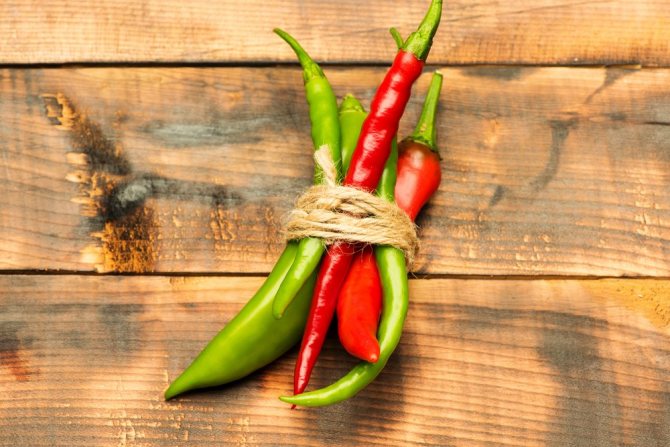

Summing up what has been said, it should be noted: hot pepper is a useful vegetable that is actively used by culinary specialists, cosmetologists, physicians and traditional healers. It contains many valuable elements in its composition, has a number of beneficial effects on the human body. But not everyone can use a spicy product (and in small quantities). Before using it, you should make sure that you do not fall into the category of persons for whom it is contraindicated.


